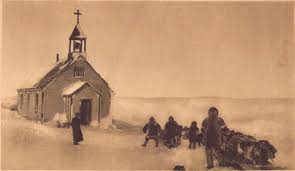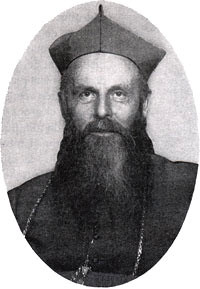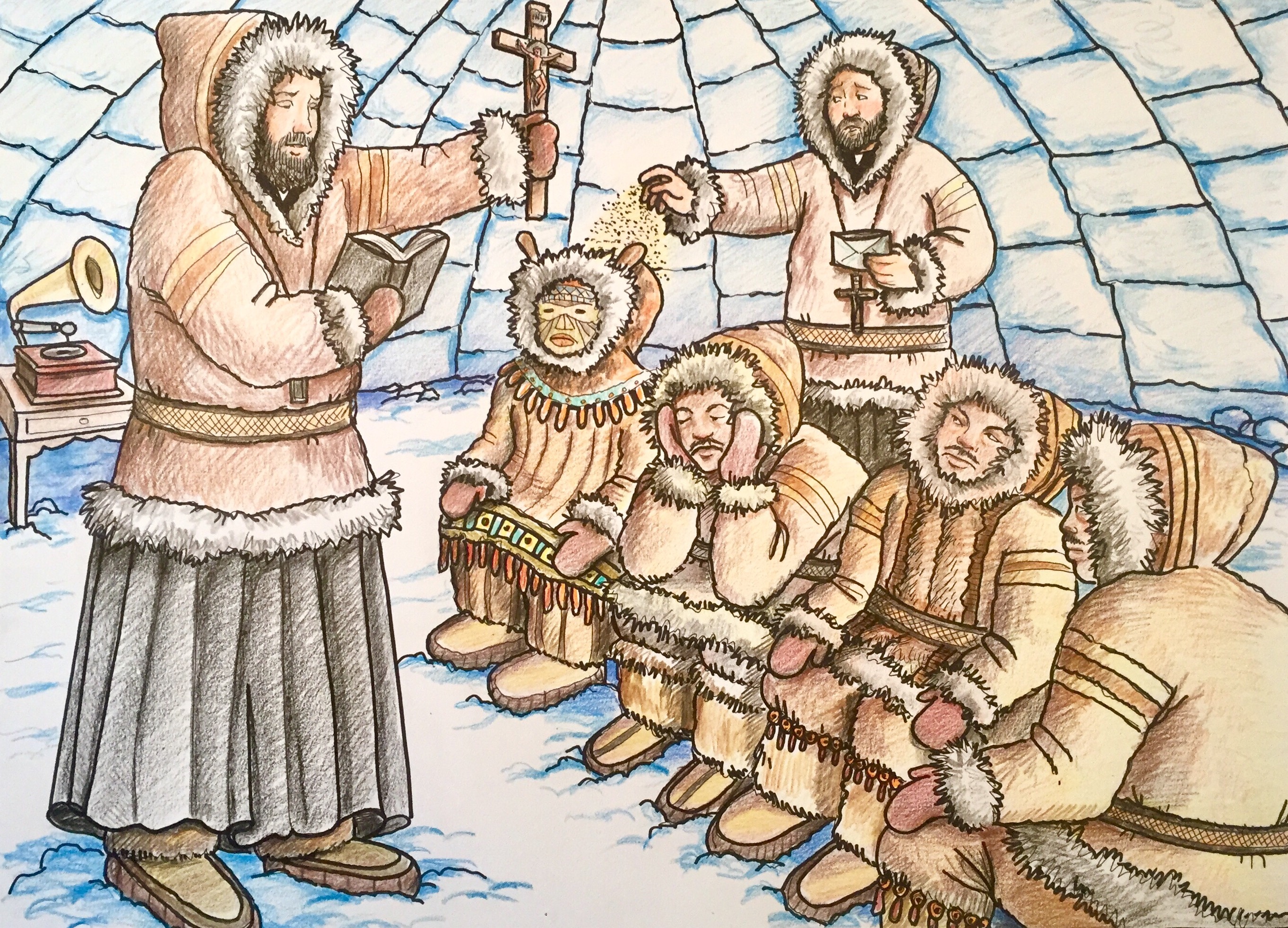Saint Thérèse and the conversion of the Eskimos
 During the life of their founder, St. Eugene de Mazenod, the Oblates of Mary Immaculate were needed to lend their services to the evangelization of Canada. The first six missionaries arrived in Montreal in December of 1841. In 1845 they entered the service of Bishop Provencher, Vicar Apostolic of all of Western Canada. It was from there that this great missionary epic was to begin, promoted by an advertisement in the colors of romantic literature according to the taste of the time, where people were happy to tell us about their travels in sleds or canoes. The fact is that in 1859 these pioneers reached the Arctic Circle, where they made their first contact with the Eskimos. Then, having crossed the Labrador lands in 1866, they were able to inaugurate the Hudson Bay mission in 1912.
During the life of their founder, St. Eugene de Mazenod, the Oblates of Mary Immaculate were needed to lend their services to the evangelization of Canada. The first six missionaries arrived in Montreal in December of 1841. In 1845 they entered the service of Bishop Provencher, Vicar Apostolic of all of Western Canada. It was from there that this great missionary epic was to begin, promoted by an advertisement in the colors of romantic literature according to the taste of the time, where people were happy to tell us about their travels in sleds or canoes. The fact is that in 1859 these pioneers reached the Arctic Circle, where they made their first contact with the Eskimos. Then, having crossed the Labrador lands in 1866, they were able to inaugurate the Hudson Bay mission in 1912.
 It was then that a young French seminarian became enthusiastic about the evangelization of the Eskimos. It was the Norman Arsène Turquetil (1876-1955). He was 24 years old in 1900, when he embarked for the Apostolic Vicariate of Saskatchewan, Canada. There, he first crossed Caribou Lake by canoe, before undertaking a seven-day sleigh trip, which brought him into contact with the Eskimos, whose language he first had to learn. But evangelization is difficult, and the missionaries have already sunk into pessimism. “The Eskimos! The Eskimos!” said his superior. “I’ve been begging the Lord for more than 30 years to send a missionary to them…” (Bro. Henri-Marie: “Mgr Turquetil and St. Therese in Eskimo country”, in “Les Annales de Ste Thérèse de Lisieux” 1932, p.133).
It was then that a young French seminarian became enthusiastic about the evangelization of the Eskimos. It was the Norman Arsène Turquetil (1876-1955). He was 24 years old in 1900, when he embarked for the Apostolic Vicariate of Saskatchewan, Canada. There, he first crossed Caribou Lake by canoe, before undertaking a seven-day sleigh trip, which brought him into contact with the Eskimos, whose language he first had to learn. But evangelization is difficult, and the missionaries have already sunk into pessimism. “The Eskimos! The Eskimos!” said his superior. “I’ve been begging the Lord for more than 30 years to send a missionary to them…” (Bro. Henri-Marie: “Mgr Turquetil and St. Therese in Eskimo country”, in “Les Annales de Ste Thérèse de Lisieux” 1932, p.133).
For the people of Hudson Bay, the hour of grace was to ring with the creation of the Apostolic Vicariate of Keewatin. Then his first prelate, Bishop Ovide Charlebois (1862-1933) assigned Father Turquetil the task of founding a mission at Chesterfield Inlet, in the middle of “Inuit” Eskimo territory. Father Turquetil went there in August 1912 with two companions. First of all, they experienced a great year of total solitude in this desert of snow and ice that kept them cut off from the rest of the world. There they tried to learn the language of the inhabitants, without grammar or a dictionary, simply by listening, observing and the few questions they managed to ask the people. Naturally, contempt and mockery were often felt by the interlocutors. And soon, in November 1913, the news that struck and dismayed them: the martyrdom of the Oblate missionaries from the neighboring Vicariate. So Bishop Charlebois decided to close the mission which was proving to be sterile and without hope for the future.
It was then that the annual mail from Europe arrived, from the Norman Diocese of Bayeux, and more specifically from Lisieux. It contains a shortened life of Sister Thérèse of the Child Jesus, whose mortal remains have just been pulled from the dust of the tomb for a first exhumation. So: a saint from her native Normandy, who committed herself to help the missionaries and who seems to be keeping her promise? Let’s do an experiment… All this really belongs to history and shows that everything was done in faith. And that the great miracle-worker was able to meet the expectations.
“Tomorrow morning,” Father Turquetil told Brother Girard, “we’ll give it a try. When the Eskimos are gathered in the hall to listen to the gramophone, I will give them a catechesis in order. And while I am talking to them, you will invoke little Therese. She herself will know how to open all her little bags and pour the contents on the heads of my listeners”. And the great surprise arrives without further delay, the very next day, when the wizard of Chesterfield, hitherto a bitter enemy of the mission, comes to ask for the baptism, adding with a resolute tone: “From now on I will come here every day; and I will do everything you tell me, because I do not want to go to hell…”. (The Annals …” p.136).
This first conversion would commit many other Eskimos to prepare for baptism. On July 2, 1917, the missionaries baptized twelve of them. And these neophytes showed great Eucharistic fervor. So much so that, full of admiration and gratitude, the missionaries no longer hesitated to acknowledge a miracle obtained by Thérèse from Normandie. On the occasion of his pastoral visit to the mission of Chesterfield in 1923, Bishop Ovide Charlebois, who had previously wanted to abolish the mission, decided instead to create new missionary centres. Soon the first church in honour of Blessed Thérèse of the Child Jesus was built at Pointe-aux-Esquimaux.
Bishop Ovide Charlebois
On May 17, 1925, Fr. Arsène Turquetil, after a visit to France, found himself in Canada. Two months later, on July 15, he was appointed first Prefect Apostolic of Hudson Bay. Quite naturally, the new missionary circumscription was entrusted to the heavenly Patronage of the new Saint, who had loved snow so much, and who above all had promised to spend her heaven doing good on earth. In the chapel, her statue quickly became an attraction for the Eskimos. Under the impulse of the new prelate, four new mission stations were soon opened. Then Bishop Turquetil was able to inaugurate the “St. Theresa’s” hospital in Chesterfield, the first hospital in the Far North, having the heating and some other conveniences of modern civilization installed there. The evolution of the region so surprised the Congregation for the Propagation of the Faith that it raised the Mission to the rank of Apostolic Vicariate in July 1931 and conferred episcopal consecration on Bishop Turquetil on 23 February 1932. It was at this time that his heavenly Patroness saved him from many dangers in his difficult journeys and clearly helped him in the development of the Mission (Dominique Menvielle: “L’épopée blanche”. Un Normand contemporain de Thérèse Martin, apôtre des Indiens et des Esquimaux”, in “Thérèse de Lisieux” 875 (March 2007),p. 2-6).
The least that can be said is that the reports issued seem extraordinarily charismatic. Yet they are well confirmed by the facts. And other important events are still to come, which will interest us more directly.
The Canadian layman Paul Lionel Bernard (1889-1965) was an enthusiastic theresian from the beginning (“Les Annales de Ste Thérèse de Lisieux” 1966/2, p. 23; Stéphane Piat: “Un chevalier servant de la gloire thérésienne, Paul Lionel Bernard”, in “Les Annales…”). 1966/10, p.4-6). As early as 1910, he began an assiduous relationship with the Carmelite convent in Lisieux which was to last all his life, even leading him to take care of the beatification of the parents of St. Thérèse as early as 1957. In 1917, he presented himself as the spokesman of his country by requesting from Benedict XV the rapid beatification of the young Carmelite thaumaturge. He succeeded in sending 12 volumes to the Pope, with several thousand signatures supporting his request. In 1925, he was the promoter of a report signed by the Canadian bishops on the surprising “shower of roses” of graces, healings, listened requests, celestial interventions for these northern regions of America. We know that Pius XI studied this report with interest.
One day in May 1925, while Bishop Charlebois was at the hospital Hôtel-Dieu of Montreal, Bishop Paul Lionel Bernard, from Beloeil, came to visit him to have him sign a letter of thanks to Pope Pius XI for the canonization of Saint Thérèse. Bishop Bernard knew of Ovide Charlebois’ devotion to the saint, and was certain that he would sign. “I will not sign this,” Bishop Charlebois told him. At Bishop Bernard’s urging, he again said firmly, “No, I won’t, because as we are writing to the pope, I’ll ask him for something else.” – “What would you ask him, Excellency?” asked Paul Lionel Bernard. – ”I would ask him to proclaim Saint Thérèse as Patroness of the missions and missionaries,” said Ovide Charlebois. This idea pleased Bishop Bernard who had all the missionary bishops of Canada sign. The proposal was presented to the Pope in March 1926. But a difficulty arose in the Roman Curia. Cardinal Van Rossum, Prefect of Propaganda, wondered if the Canadian petition should refer only to the Missions of that country, or rather to the Missions of the whole world. If the latter, the world missionary episcopate should be consulted.
Once the task had begun, Bishop Charlebois could count, as early as March 1927, with 232 positive responses. And some of the letters brought enthusiastic news, for many Vicars Apostolic throughout the world recognized, in their turn, clear signs of the intercession of the Carmelite nun of Lisieux. The magazine “Rain of Roses”, moreover, relates hundreds of cases (Between 1913 and 1925, seven volumes were published, that is to say 3,750 pages). Mary of the Redemption, Ursuline of Trois-Rivières and a great friend of Mother Agnes of Jesus, took it upon herself to bind the packet of adhesion sheets herself and to prepare a very neat album, which was given to Pius XI on October 14, 1927. The Pope examined it with admiration. However, the Congregations of Rites and Propagation of the Faith were opposed to the granting of the title of Patroness of the Missions. The Pope must therefore insist that the situation be studied more closely. And his remarks ended up by deciding the Congregation of Rites to prepare the Decree which was to proclaim St. Therese of the Child Jesus universal Patroness of the Missions on December 14, 1927.
In an admirable synthesis, Bishop Charlebois was then able to write to the Carmelite congregation in Lisieux: “I must not be given all the credit. I admit that I suggested the idea and lent my name; but for the rest, we must take into account certain people who have devoted themselves to this cause in an admirable way, as well as your own prayers. And above all we have had our good little Saint, who from heaven has not ceased to drop her roses successfully on all our countries. It was indeed she who desired with all her heart to become the Patroness of all the missionaries whom she always loved so much, and for whom she suffered so much” (“Les Annales…” 1928, p.88).


